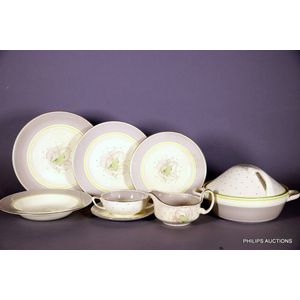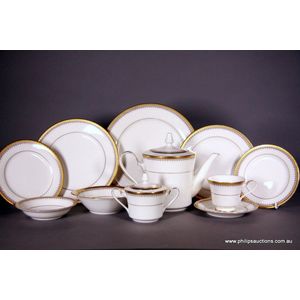Noritake Dinner Service, Edinburgh Pattern, 62 Pieces
You must be a subscriber, and be logged in to view price and dealer details.
Subscribe Now to view actual auction price for this item
When you subscribe, you have the option of setting the currency in which to display prices to $Au, $US, $NZ or Stg.
- Lambrequin Border - A lambrequin border is a decorative motif and consists of a series of overlapping scalloped or pointed shapes, resembling the drapery of a lambrequin, a type of decorative hanging usually made of fabric or leather that was used to adorn the tops of doors or windows.
In ceramics, the lambrequin border was a popular decorative element in the 19th and early 20th centuries. It was often used to embellish the edges of plates, platters, bowls, and other serving pieces, as well as on vases, jars, and other decorative items. The border was typically applied using a transfer printing technique or hand-painted by skilled artisans.
The lambrequin border was popular in many different styles of ceramics, including those made in the majolica, transferware, and Art Nouveau styles. It was often combined with other decorative motifs, such as floral or foliate patterns, to create a rich and ornate design. - Circa - A Latin term meaning 'about', often used in the antique trade to give an approximate date for the piece, usually considered to be five years on either side of the circa year. Thus, circa 1900 means the piece was made about 1900, probably between 1895 and 1905. The expression is sometimes abbreviated to c.1900.
This item has been included into following indexes:
- Japanese ceramics, factories and cities - Noritake wares 119
- Japanese ceramics, item types - other 2,592
-
Satsuma (Japan), item type
- bowls 566
- plates, platters and chargers 575
- tea ware 214
Visually similar items

A fifty eight piece Royal Doulton dinner service. 1968 to 2008 production period, 'Royal gold' pattern H 4980, in soft white with an anthemion patterned gold border, a setting for eight comprising dinner, entree, side plates, soup or dessert bowls, coffee

A seventy-five piece Susie Cooper Magnolia pattern dinner service, circa 1930s, with leaping deer mark of Susie Cooper production, comprising four tureens, two gravy boats, twelve soup coupes with ten saucers, eleven shallow bowls, plates in three sizes, t

A Wedgwood dinner service for eight, 1963-2005, California pattern number W4377, the fifty six piece service in white with a simple gold trim comprising dinner, side and cake plates, bouillon bowls and associated saucers, coffee cans and saucers; backstamp

A one hundred and Forty two piece Royal Doulton dinner service, 1984-1998, production period, in 'Heather' pattern H 5089, Albion shape, a near complete setting for twenty four places in cream with gold trims, comprising twenty three cups and twenty four s
